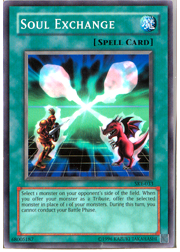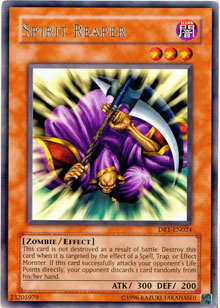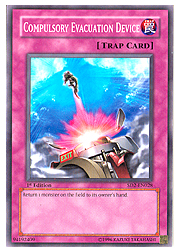
With a firm understanding of Soul Exchange’s basic functions, we can now look at problematic situations that arise from its use. Some card interactions simply don’t work with Soul Exchange, while others can have unexpected results. Having a firm understanding of them will better prepare you for situations you may encounter.
Immediate Exchange?
 After you activate Soul Exchange, the next time you offer a monster as a tribute, you must use the monster that you targeted with Soul Exchange. You cannot use another monster, so you need to make sure that you plan your turn properly.
After you activate Soul Exchange, the next time you offer a monster as a tribute, you must use the monster that you targeted with Soul Exchange. You cannot use another monster, so you need to make sure that you plan your turn properly.
Example: Two Paths
You have three cards in your hand—Metamorphosis, Soul Exchange, and Zaborg the Thunder Monarch—and a face-up Treeborn Frog on your side of the field. Your opponent has only a face-up Cyber Dragon on her side of the field.
If you play Soul Exchange, you will have to use your opponent’s Cyber Dragon as the target, and the very next tribute you make will have to be that very same Cyber Dragon. If you decide to use Metamorphosis, you will have to tribute the targeted Cyber Dragon and special summon a level 5 fusion monster from your fusion deck. If you decide to summon Zaborg, you will have to tribute the targeted Cyber Dragon for the summon.
Because you used Soul Exchange, you cannot decide to tribute your Treeborn Frog first. Soul Exchange demands that its targeted monster be tributed first. It won’t allow any other monster to step in the way.
Monster Soul
 Spirit Reaper has an interesting interaction with Soul Exchange. Since Soul Exchange is a targeting effect, if you use it to target your opponent’s face-up Spirit Reaper, the Reaper will destroy itself with its own effect. This means that it will not survive long enough to be tributed. It helps clear Spirit Reaper out of the way, but we must remember that activating Soul Exchange means losing our battle phase. That’s a pretty hefty cost to pay just to wipe out a Spirit Reaper.
Spirit Reaper has an interesting interaction with Soul Exchange. Since Soul Exchange is a targeting effect, if you use it to target your opponent’s face-up Spirit Reaper, the Reaper will destroy itself with its own effect. This means that it will not survive long enough to be tributed. It helps clear Spirit Reaper out of the way, but we must remember that activating Soul Exchange means losing our battle phase. That’s a pretty hefty cost to pay just to wipe out a Spirit Reaper.
The ever-popular Sheep tokens generated by Scapegoat and the infamous Ojama tokens generated by Ojama Trio have restrictions placed upon them by their source cards that prevent them from being used as a tributes for a tribute summon. When using Soul Exchange, you can choose to target either of the monster tokens, but you will be limited by their restriction. This means that you still cannot tribute them for a tribute summon, though you can use them for a ritual spell card or to pay a card effect.
Troubles with Face Downs
Soul Exchange does not restrict the state of your opponent’s monster when you target it. For this reason, you can use it to target face-up or face-down monsters your opponent controls. While face-up monsters normally fall into line without issue, face-down monsters can cause problems. Take Metamorphosis, for instance. It’s entirely possible that the face-down monster you targeted could be a level 2 monster card. Initially, this doesn’t sound like a problem, until you look through your collection of cards and realize that there aren’t any level 2 fusion monsters.
Such a scenario doesn’t occur frequently, but it’s part of another issue that needs addressing. What if you tributed your opponent’s face-down monster for Metamorphosis and it turned out you didn’t even have a fusion monster of the same level in your fusion deck? Ultimately, Metamorphosis cannot be used in connection with Soul Exchange if the targeted monster is face-down. If the monster is face-up, you will already be able to determine if it can function with your Metamorphosis, and you won’t have a problem.
Then we have Big Shield Gardna, leading us to an entirely different issue.
A Matter of Negation
If you have the misfortune of targeting your opponent’s face-down Big Shield Gardna, it will flip face-up and negate the activation and effect of your Soul Exchange. This means that you will not be able to use it as a tribute, but it also means that you still get to conduct your battle phase.
When Soul Exchange is negated, the method used to negate it can cause different results. If a card negates Soul Exchanges’s activation, you will be able to conduct your battle phase for the turn. If a card negates only the effect of Soul Exchange, however, you will not be able to conduct your battle phase.
Cards like Magic Jammer and the previously mentioned Big Shield Gardna will negate the activation and the effect of Soul Exchange, so if your opponent uses either of them, you can try to use your battle phase to make up for what you lost. If he or she uses a card like Imperial Order, you’ll be out of luck.
 In some cases, your opponent can use a card which has no intention of negating Soul Exchange, but which can still cause irreparable harm. Suppose you activate Soul Exchange and target your opponent’s monster. When your opponent responds, he uses Compulsory Evacuation Device to return the monster to his hand. In this situation, his monster will return to his hand before your Soul Exchange resolves. How does this affect Soul Exchange?
In some cases, your opponent can use a card which has no intention of negating Soul Exchange, but which can still cause irreparable harm. Suppose you activate Soul Exchange and target your opponent’s monster. When your opponent responds, he uses Compulsory Evacuation Device to return the monster to his hand. In this situation, his monster will return to his hand before your Soul Exchange resolves. How does this affect Soul Exchange?
Compulsory Evacuation Device doesn’t negate the activation or the effect of Soul Exchange, so it will still try to resolve. Without its targeted monster on the field, it will fail, but unfortunately it will still cost you a battle phase. The same can be said of any card that will remove the opponent’s monster from the field, like Ring of Destruction or Interdimensional Matter Transporter.
Like Last Will, Soul Exchange has found a place for itself amongst the newest cards, despite its age. As time goes on, players are bound to find new uses for it that will keep it around for a long time to come.
Until next time, send all comments and questions to: Curtis@Metagame.com